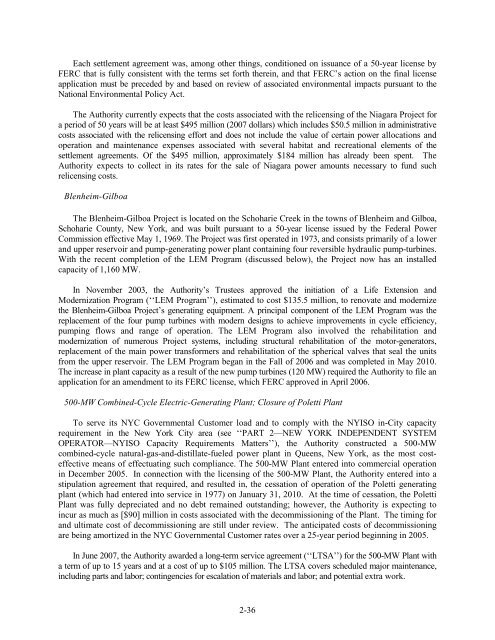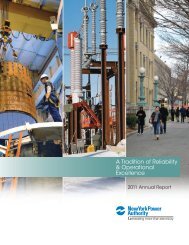July (pdf) - New York Power Authority
July (pdf) - New York Power Authority
July (pdf) - New York Power Authority
You also want an ePaper? Increase the reach of your titles
YUMPU automatically turns print PDFs into web optimized ePapers that Google loves.
Each settlement agreement was, among other things, conditioned on issuance of a 50-year license by<br />
FERC that is fully consistent with the terms set forth therein, and that FERC’s action on the final license<br />
application must be preceded by and based on review of associated environmental impacts pursuant to the<br />
National Environmental Policy Act.<br />
The <strong>Authority</strong> currently expects that the costs associated with the relicensing of the Niagara Project for<br />
a period of 50 years will be at least $495 million (2007 dollars) which includes $50.5 million in administrative<br />
costs associated with the relicensing effort and does not include the value of certain power allocations and<br />
operation and maintenance expenses associated with several habitat and recreational elements of the<br />
settlement agreements. Of the $495 million, approximately $184 million has already been spent. The<br />
<strong>Authority</strong> expects to collect in its rates for the sale of Niagara power amounts necessary to fund such<br />
relicensing costs.<br />
Blenheim-Gilboa<br />
The Blenheim-Gilboa Project is located on the Schoharie Creek in the towns of Blenheim and Gilboa,<br />
Schoharie County, <strong>New</strong> <strong>York</strong>, and was built pursuant to a 50-year license issued by the Federal <strong>Power</strong><br />
Commission effective May 1, 1969. The Project was first operated in 1973, and consists primarily of a lower<br />
and upper reservoir and pump-generating power plant containing four reversible hydraulic pump-turbines.<br />
With the recent completion of the LEM Program (discussed below), the Project now has an installed<br />
capacity of 1,160 MW.<br />
In November 2003, the <strong>Authority</strong>’s Trustees approved the initiation of a Life Extension and<br />
Modernization Program (‘‘LEM Program’’), estimated to cost $135.5 million, to renovate and modernize<br />
the Blenheim-Gilboa Project’s generating equipment. A principal component of the LEM Program was the<br />
replacement of the four pump turbines with modern designs to achieve improvements in cycle efficiency,<br />
pumping flows and range of operation. The LEM Program also involved the rehabilitation and<br />
modernization of numerous Project systems, including structural rehabilitation of the motor-generators,<br />
replacement of the main power transformers and rehabilitation of the spherical valves that seal the units<br />
from the upper reservoir. The LEM Program began in the Fall of 2006 and was completed in May 2010.<br />
The increase in plant capacity as a result of the new pump turbines (120 MW) required the <strong>Authority</strong> to file an<br />
application for an amendment to its FERC license, which FERC approved in April 2006.<br />
500-MW Combined-Cycle Electric-Generating Plant; Closure of Poletti Plant<br />
To serve its NYC Governmental Customer load and to comply with the NYISO in-City capacity<br />
requirement in the <strong>New</strong> <strong>York</strong> City area (see ‘‘PART 2—NEW YORK INDEPENDENT SYSTEM<br />
OPERATOR—NYISO Capacity Requirements Matters’’), the <strong>Authority</strong> constructed a 500-MW<br />
combined-cycle natural-gas-and-distillate-fueled power plant in Queens, <strong>New</strong> <strong>York</strong>, as the most costeffective<br />
means of effectuating such compliance. The 500-MW Plant entered into commercial operation<br />
in December 2005. In connection with the licensing of the 500-MW Plant, the <strong>Authority</strong> entered into a<br />
stipulation agreement that required, and resulted in, the cessation of operation of the Poletti generating<br />
plant (which had entered into service in 1977) on January 31, 2010. At the time of cessation, the Poletti<br />
Plant was fully depreciated and no debt remained outstanding; however, the <strong>Authority</strong> is expecting to<br />
incur as much as [$90] million in costs associated with the decommissioning of the Plant. The timing for<br />
and ultimate cost of decommissioning are still under review. The anticipated costs of decommissioning<br />
are being amortized in the NYC Governmental Customer rates over a 25-year period beginning in 2005.<br />
In June 2007, the <strong>Authority</strong> awarded a long-term service agreement (‘‘LTSA’’) for the 500-MW Plant with<br />
a term of up to 15 years and at a cost of up to $105 million. The LTSA covers scheduled major maintenance,<br />
including parts and labor; contingencies for escalation of materials and labor; and potential extra work.<br />
2-36
















